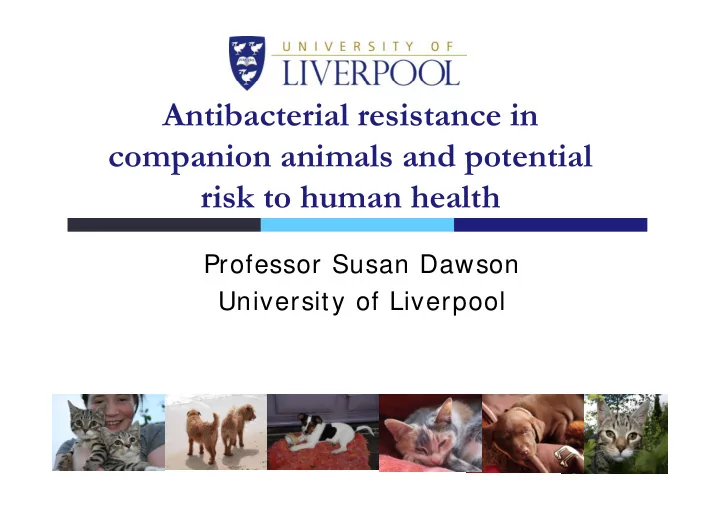

Antibacterial resistance in companion animals and potential risk to human health risk to human health Professor Susan Dawson f S University of Liverpool y p
C Companion animals l Pets in households – half of households Dogs 8-10 million dogs Cats – 8-10 million cats Other pets Horses – 3.5 million people have been horse riding in last 12 months (6% g ( population) Direct contact with people Direct contact with people
Veterinary Use of Antibiotics Veterinary Use of Antibiotics POM-V POM V Treatment of and prophylaxis for bacterial disease in animals Prescribed by vets y Adminstered by vets, owners, stable owners etc owners etc Compliance
Cascade Cascade Veterinary surgeons must prescribe and V t i t ib d use veterinary medicines where available If no medicine is authorised can then use A vet medicine authorised in UK for another species or another condition Or if not a medicine authorised for human use in UK Or imported from another member State O i t d f th b St t
Vets prescribing - dogs b d Completion of a prescription log over 5 days; antimicrobial used and presenting complaint 2 5 .9 % of dogs seen by vets were g y prescribed antimicrobials Penicillins (esp. amoxicillin/ clavulanic Penicillins (esp. amoxicillin/ clavulanic acid) were the most frequently prescribed Fluoroquinolones – 5 6% of antibacterial Fluoroquinolones 5.6% of antibacterial prescriptions; 3 rd generation cephalosporins 1 3% cephalosporins 1.3%
Vets prescribing – dogs cont. b d No prescriptions for carbapenems recorded Most commonly used for wounds, abscesses or skin infections 16% prescriptions for prophylaxis 3 3% of prescriptions were for products 3.3% of prescriptions were for products not licensed for dogs
Vets prescribing - horses b h 1 7 % of horses attended by vets were prescribed antibacterials 34.4% potentiated sulphonam ides 23.5% penicillins 14.3% aminoglycosides 5.1% fluoroquinolones 3.1% 3 rd and 4 th gen cephalosporins
Vets prescribing – horses cont b h 3 8 % of prescriptions were for products not licensed for horses 74% of horse vets reported that they were not aware of any available antibiotic y guidelines Information gained from cpd events, Information gained from cpd events, pharmaceutical companies, datasheets
Prevalence of antibacterial resistant E.coli in healthy dogs (183 dogs) l h l h d d ) Dogs in the community 2 9 % of dogs carried at least one AMR g E.coli 2 4 % dogs had isolates resistant to 2 4 % dogs had isolates resistant to amplicillin 20% to tetracycline 20% to tetracycline 17% to trimethoprim 1 5 % of dogs had multidrug resistant f d h d l d isolates (3 or more) Only one ESBL
Dogs attending vets (581 faecal samples) l ) 4 5 % of faecal samples had AR E.coli Ampicillin 37% p Tetracycline 30% Trimethoprim 24% Trimethoprim 24% Ciprofloxacin 5% 1 8 % samples had multidrug resistant E.coli 4 .1 % ESBL
Resistant E.coli in hunt dog kennels l h d k l 4 hunt kennels; 110 faecal samples Ampicillin resistant E.coli found in 1 0 0 % p faecal samples Over 8 0 % multidrug resistant Over 8 0 % multidrug resistant No ESBL producing E.coli identified Use of antibacterials was reported to be Use of antibacterials was reported to be frequent; wounds and injuries
Prevalence of antimicrobial resistant E.coli in horses (650 faecal samples) l h f l l ) 7 2 % samples positive for any resistance 56% trimethoprim p 51% tetracycline 46% ampicillin 46% ampicillin 5.4% ciprofloxacin 3 8 % multidrug resistance 6.3% ESBL resistance
Horses in referral hospitals f l h l 103 horses; 457 faecal samples Samples collected within 48 hours of p arrival and every two days until discharge 2 9 % samples positive for ESBL producing 2 9 % samples positive for ESBL producing bacteria Prevalence of resistance lower at Prevalence of resistance lower at admission with a peak at 4 days of hospitalisation hospitalisation PFGE suggested transmission between horses horses
ESBL producing E.coli in horses S d l h Majority carried bla CTX-M-1 Also carried bla CTX-M-14 , bla CTX-M-9, bla CTX-M-20, , bla CTX-M-65 Median duration of shedding 22 days Median duration of shedding 22 days
MRSA in humans SA h Healthcare associated MRSA – HA-MRSA Community associated MRSA – CA-MRSA y Livestock associated MRSA – LA-MRSA
MRSA in companion animals MRSA in companion animals Dogs attending vets (consultation only) 724 dogs g MRSA 1% MSSA 6.5% MSSA 6.5% MR-CNS 5.5% S.pseudintermedius 11% (none MR) S.pseudintermedius 11% (none MR)
MRSA in horses MRSA in horses Horses attended by vets (not hospitalised) p ) 678 horses MRSA 0 6% MRSA 0.6% MRS 29% 78% of isolates were multidrug resistant
Risk to humans k h High level of contact Low levels of MRSA carriage; transmission g ; has been demonstrated Transmission of MRSA from humans to Transmission of MRSA from humans to animals High prevalence of E coli carrying AR High prevalence of E.coli carrying AR especially in certain populations of dogs and horses and horses
Aims Maintain efficacy in animals Maintain efficacy in people y p p Develop new drugs Maintain our ability as vets to prescribe Maintain our ability as vets to prescribe Ensure infection control with other measures measures
Thank you for your attention! Thank you for your attention! Nicola Williams Tom Maddox Amy Wedley Pete Clegg Pete Clegg Gina Pinchbeck Tim Nuttall Defra Bransby Home of Rest for Horses Rest for Horses
Recommend
More recommend